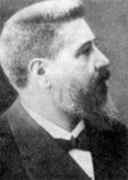Person: Andoyer, Henri

Henri Andoyer was a French astronomer and mathematician who worked on the motion of the moon. He published mathematical tables and works on the history of astronomy.
Mathematical Profile (Excerpt):
- Andoyer's secondary education came at first at Harcourt College and then at the lycée St Louis, a secondary school located in the Latin Quarter of Paris, which he entered in 1872.
- Andoyer went on in 1881 to attend the École Normale Supérieure, one of the most highly regarded and prestigious higher education establishments outside of the public university system framework, having come top of the list in the entrance examination for the Grandes Écoles.
- In 1912 he succeeded Henri Poincaré as Professor of General Astronomy and Celestial Mechanics following Poincaré's death.
- An elementary exposition of the theory of eclipses of moon and sun and of the occultation of stars by the moon finally ends this first part of Professor Andoyer's treatise.
- Besides teaching, Andoyer's work involved a lot of observational study.
- Andoyer claimed that though Delaunay's terms were accurate up to the 7th order, beyond that they were very inaccurate.
- Andoyer also studied the nnn-body problem, the problem of predicting the individual motions of a group of celestial bodies gravitationally interacting with each other, expanding the results of Joseph Lagrange concerning the equilibrium solutions for three bodies.
- Following the death of Jean Charles Rodolphe Radau (1835-1911) on 21 December 1911, Andoyer succeeded him in the role of writing the Connaissance des temps Ⓣ(Understanding time), an annual publication of astronomical ephemerides in France.
- Andoyer was very dedicated to his teaching and to his pupils, publishing many of his lectures for their benefit, several of which we listed above.
- Andoyer cites the problems in celestial mechanics, which the eighteenth century mathematicians encountered, and reminds the reader how, through insufficient approximation, doubt was cast for a time upon the validity of Newton's law of inverse squares, and how a closer numerical approximation dispelled those doubts.
- Andoyer presents evidence showing the excessive harshness of the judgment passed upon Laplace by certain writers, to the effect that Laplace, in his writings, often failed to give due credit to his predecessors and contemporaries.
- Andoyer explains how Laplace again and again returned to certain topics in order that he might improve his exposition and perhaps free the subject from metaphysical entanglements.
- Andoyer's masterly account of Laplace's researches on celestial mechanics, on the figure of the earth, on the tides, on the système du monde, on the analytical theory of probability, and of researches on physics contains numerous quotations from the works of Laplace, bearing on points of scientific and philosophical interest.
- Andoyer's booklet will be enjoyed by students interested in the evolution of the mathematical sciences.
- In 1923 Andoyer published the first volume of his two volume work Cours de Mécanique Céleste Ⓣ(Course of celestial mechanics), the second volume being published in 1926.
- Andoyer was recognised for his work by receiving many honours.
- The eldest of the sons, Firmin Marie Raphäel Andoyer, born in Toulouse on 13 February 1890, was killed at Brabant-sur-Meuse on 11 January 1915 during the First World War.
- The second son, Georges Leeon Andoyer was born in Toulouse on 8 December 1890.
- This connection to Andoyer supposedly increased Humbert's interest in the history of astronomy.
- Andoyer died in Paris on 12 June 1929.
- In Andoyer a rare combination of qualities were united.
Born 1 October 1862, Paris, France. Died 12 June 1929, Paris, France.
View full biography at MacTutor
Tags relevant for this person:
Astronomy
Thank you to the contributors under CC BY-SA 4.0! 

- Github:
-

- non-Github:
- @I-J-Falconer
- @J-G-Mena
- @J-J-O'Connor
- @T-S-C-Peres
- @E-F-Robertson
References
Adapted from other CC BY-SA 4.0 Sources:
- O’Connor, John J; Robertson, Edmund F: MacTutor History of Mathematics Archive
